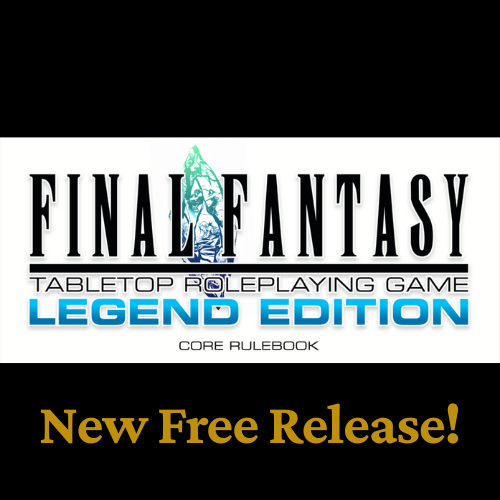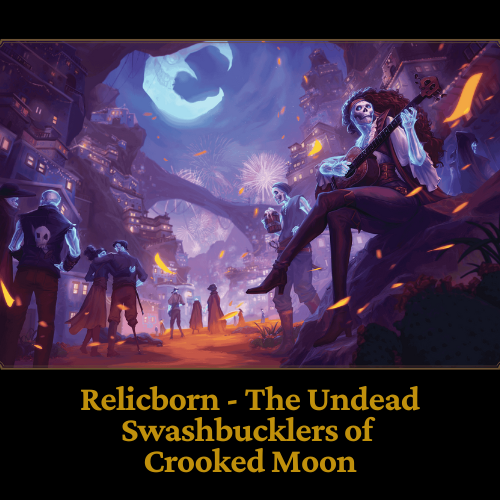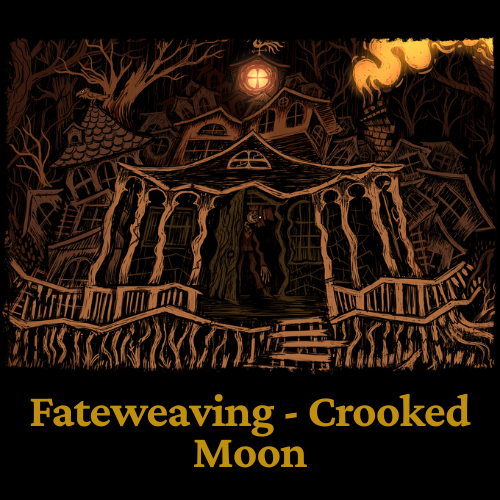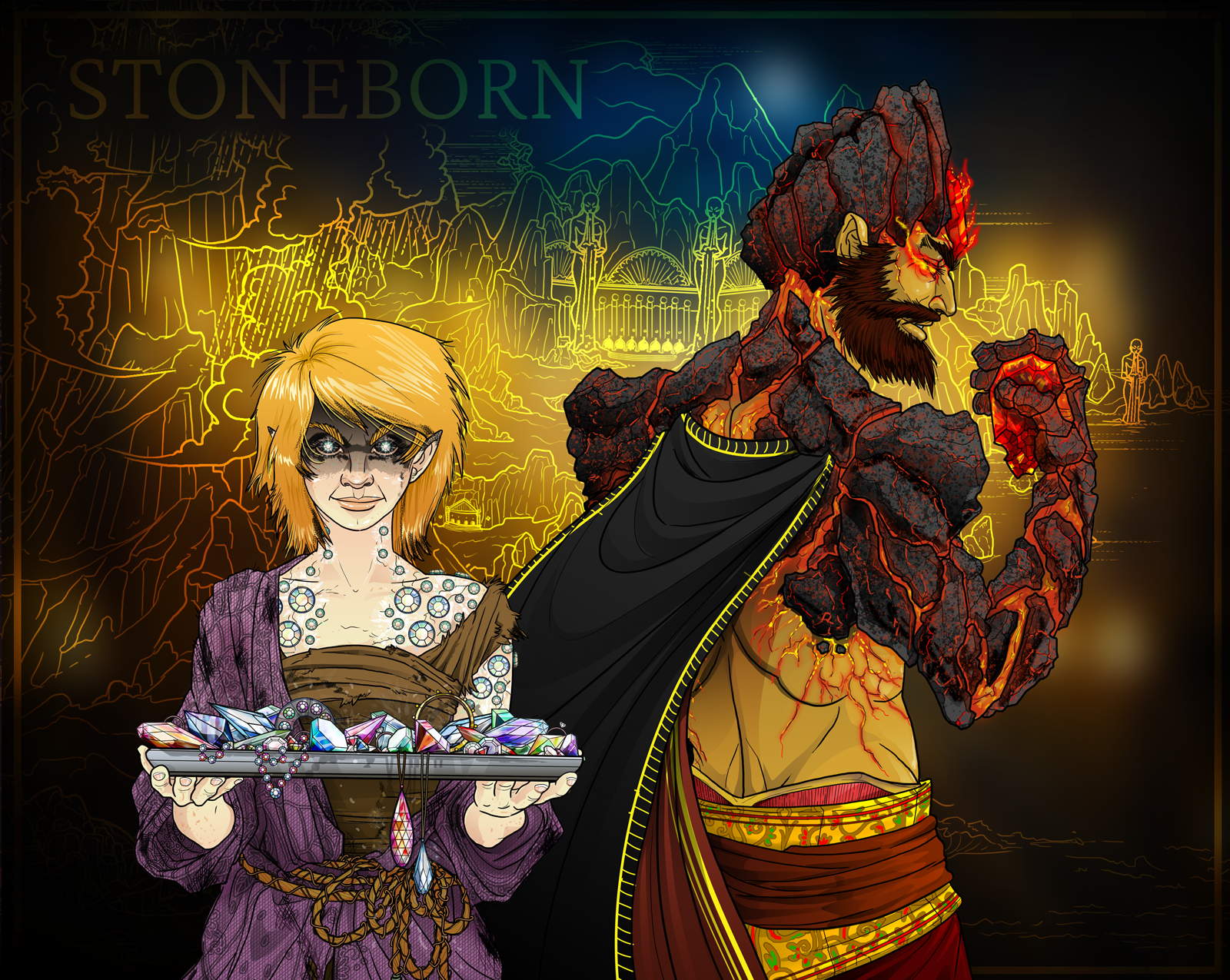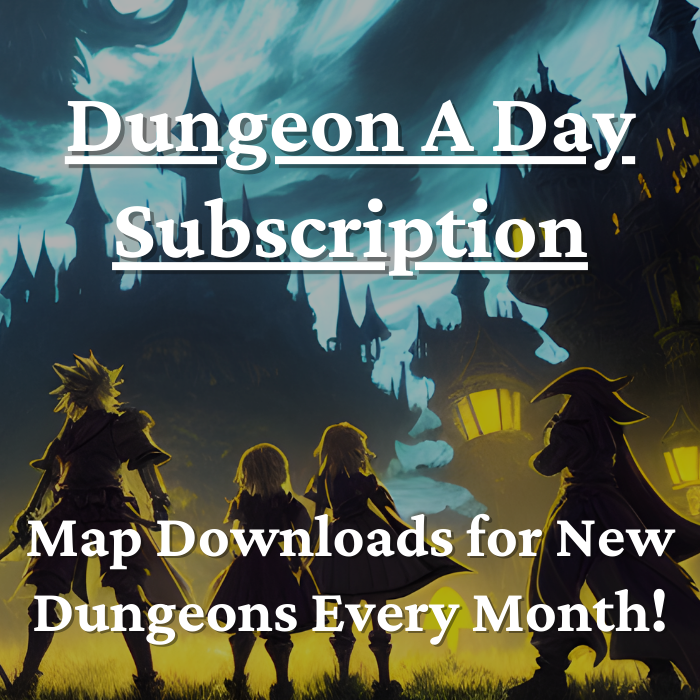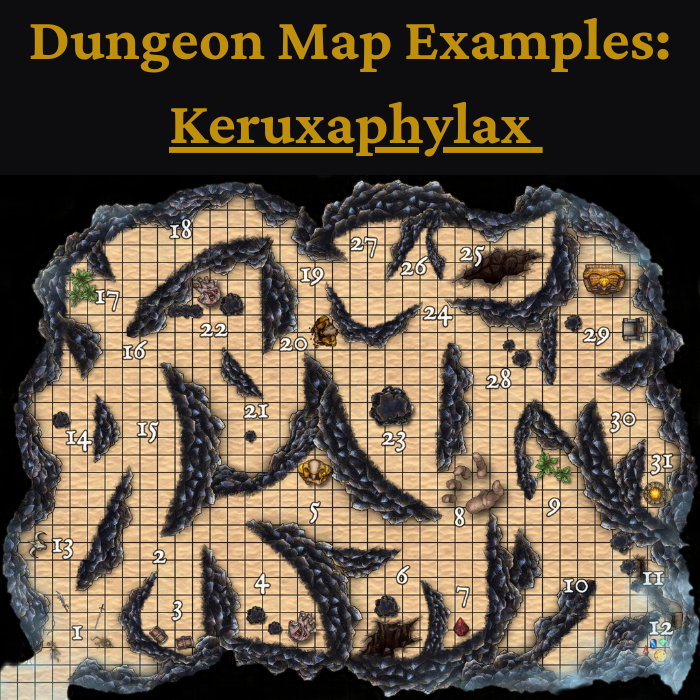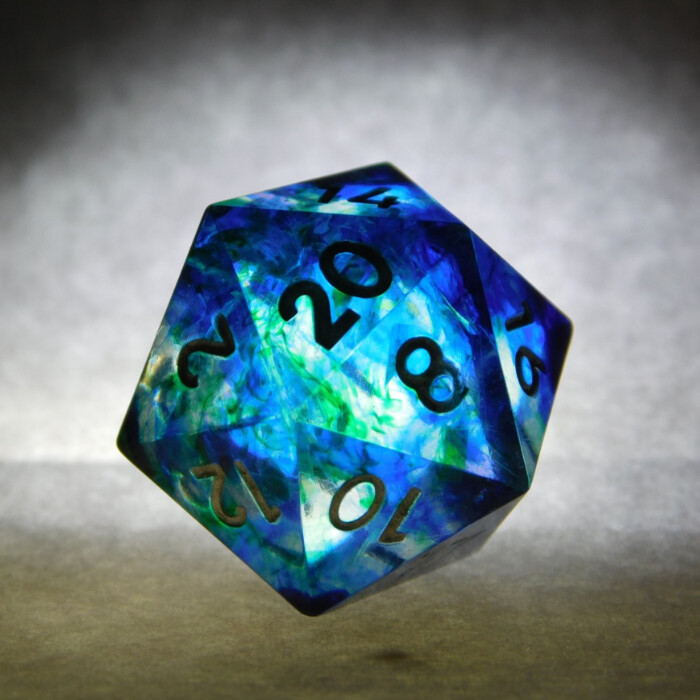Dead in the West RPG Review - Score: 76 / 100
This review is part of my new TTRPGs page, where you can find awesome Games Like DnD that you may never have heard of before. If you're interested in finding a new game to play, check out that article!
Dead in the West RPG is a newer TTRPG, Kickstarted in 2018. This game is all about the mythical American West, where players roleplay soon-to-be legendary cowboys.
My overall impression is that Dead in the West is a solid RPG, with a game system solidly based in RPG classics, but with its own unique twists. The game plays well, with very few hitches, and certainly immerses players in its genre.

How Unique is Dead in the West RPG: (6/10)
Dead in the West has a few game system elements that are unique among tabletop RPGs, though most of its uniqueness as a game comes from its setting. I want to give Dead in the West a 7/10 in this category, but I don’t feel like the “game mechanics” quite justify that score.
What’s Unique about Dead in the West
Dead in the West RPG is only the second tabletop RPG I’ve ever played that is specifically set in the “Mythical American West” (the other being Dogs in the Vineyard). Everything about the game’s lore is relatively unique, and the rulebook does a great job of encouraging players to connect everything about their characters to the way they roleplay and interact with the game world.
I find “Vigor” to be an interesting mechanic in the game, where players can improve their character’s skill or combat checks, at-will. I also generally enjoy the concept of “Hoodoo rolls” in the game, which provide a sort of “fate” element to what happens in the game’s story.
Finally, players and their GM may collaborate to create character “abilities,” which are in a sense, their special powers.
Character Abilities
In my mind, the most unique part about Dead in the West is that players and the GM can collaborate to create abilities 100% custom for each player. Abilities are also supposed to be extensions of the character, and inform how each player roleplays their character.
My only critique about abilities in Dead in the West is that though there are many ability examples provided in the book, giving power to GMs to create a game’s “powers” can be overwhelming. The idea is that if abilities end up being either 1) too powerful or 2) under-powered, players and the GM can adjust the ability over time.
Ultimately, I’m sort of torn on whether or not I really like how abilities work, but I do have to say that the concept is unique. I tend to find classless RPGs interesting, and this game might be one example among very few that makes a classless concept work.
How Easy is it to Learn Dead in the West: (8/10)
Having played quite a few tabletop RPGs, I found Dead in the West pretty simple and easy to learn. Though character creation takes up about 50-pages in the rulebook, the process is fairly straightforward.
Characters have stats, attributes, experience, demeanor, virtues and vices, and a section called “what yer pappy did.” My gaming group was confused at first between the differences of stats and attributes, and the modifier values they each gave were different from one another, so starting out the game wasn’t 100% clear on what everything did.
“Experiences” are also different in Dead in the West, as the term refers to a character’s skills and knowledge, and doesn’t relate to leveling up.
Actual Gameplay
Once characters were created, the overall feel of my gaming group was that Dead in the West fell into familiar tabletop RPG territory – in a good way. The game was easy to pick up as we explored a Western town, which eventually led to fighting bandits.
Most game mechanics function very similarly to other tabletop RPGs, so they were intuitive to use. We particularly enjoyed the “virtues and vices” of each character, as they did help us create unique personalities and roleplaying experiences. In Dead in the West, the GM can compel players to act in alignment with their virtues and vices (which are things that make them selfless or selfish, at different times), which in our case, led to some fun moments.
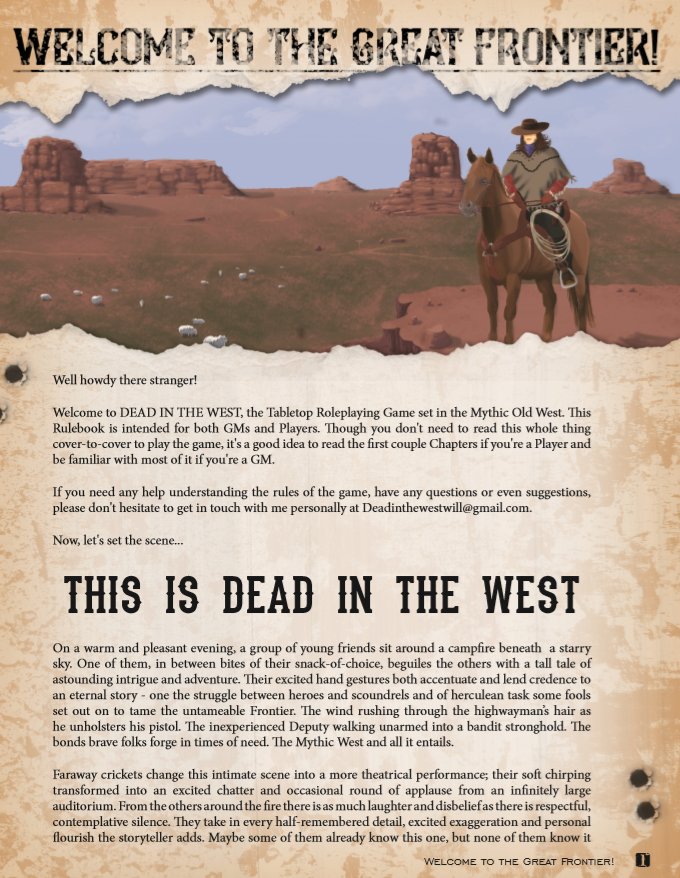
Dead in the West RPG Presentation: (9/10)
I really like the graphic design of Dead in the West RPG. The game’s rulebook has very nice formatting, font, colors, and sizing. Reading through the book, I particularly appreciated that the order of information and chapters flowed very nicely. As a new player, it was easy for me to navigate the information provided, learn the game, and reference material as-needed, during play.
I also enjoyed the game’s writing style quite a bit. The author did a great job presenting information clearly, while also making it thematic to the game’s setting, and overall fun to read.
Rulebook Length
Dead in the West RPG is written for someone who’s probably never played TTRPGs before, which is why the rulebook is so long (close to 300-pages).
I go back and forth at times on whether or not I feel that multi-hundred page TTRPG rulebooks are valuable. On the one hand, authors/ game designers need space to accurately convey their ideas, so length can be a positive.
On the other hand, in most cases, a person’s first RPG won’t be an indie RPG, so they should have a base level of understanding coming into any indie game, which would make lengthy explanations unnecessary.
Whenever I read through TTRPG rulebooks, I basically skip 75% of the text so I can read what I need in order to play. The flavor text is fun, but for me, largely unnecessary.
One Upgrade I’d Like to See
When it comes to specifics, I did wish that character vices and virtues would have a space of its own in the “Player Monitor” section of the GM Sheet. Since the GM can compel characters to act in accordance with their virtues and vices, it would’ve been nice to have a spot on that sheet where virtues and vices could be easily referenced.
Lore: (9/10)
Though there isn’t an official Dead in the West game world setting provided, the entire rulebook is basically lore. From character creation details to terms used in the game, players can’t help but feel immersed in the Mythical American West.
The game also offers some general settings to the GM – the gold rush, civil war, nearing the end of the old west, etc. – with brief explanations on each. Each of these setting could work for entire campaign ideas, or even just shorter quest ideas.
What probably seals the deal for me on lore is that Dead in the West provides a lot of in-depth information that players may use in their game’s setting, at any time. There’s info on downtime, gambling, town life, settlement building (which I think is especially cool), the benefits of character employment, and even shopping – which even includes how much it costs to buy a tin of condensed milk.
Sometimes, details provided in Dead in the West were too much for me, and I felt like they detracted from the game overall. However, so much of the game is optional in use that never felt too oppressive.
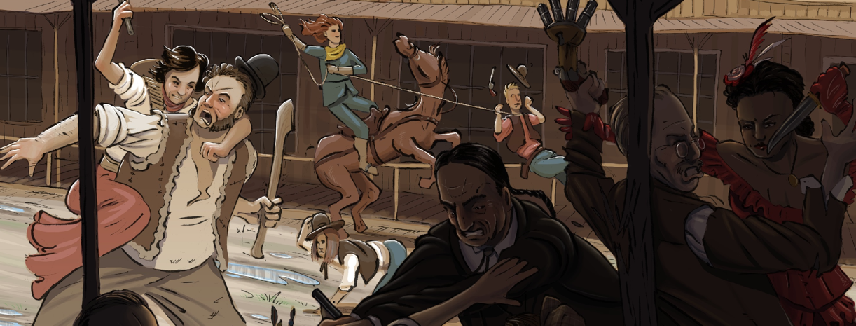
Combat in Dead in the West RPG: (4/10)
To be fair, I felt playing Dead in the West that the game is more of a “roleplay game” than a “tactical combat game,” – as in, that’s what the designer was going for. So, a low score in this combat category probably shouldn’t deter anyone from playing the game, unless like me, you love tactical combat.
How Combat Feels
Characters have a weapon, an accuracy value (based on character stats and maybe their experiences), a score for movement, and some advanced actions they can take per round.
When our group got into combat with bandits, characters would fire their gun until they needed to reload. While reloading, characters are counted as being a “sitting duck,” and they can get blown away in short order. In order to prevent that, players had their characters “dive” behind a table or something so they get “cover,” whenever they needed to reload. Once reloaded, characters started blastin’ again.
Basically, it was shoot, dive, cover, reload, then shoot again. Repeat until all enemies are dead.
There are more options available in the rulebook for ambushing enemies, “corralling” (flanking) them for increased hit chances, grappling, etc. But since the game’s abilities are all player- and GM-created, there weren’t really abilities provided that really spiced up combat tactics. The closest thing was probably mounted combat, but since that comes with its own degree of complexity, I didn’t feel like it added to combat in a substantially beneficial way.
Crack-Shots and Locational Damage
As I’ve mentioned in other reviews, such as for Warhammer Fantasy Roleplay, I’m not a fan of hit locations. Dead in the West RPG has hit locations, but you need to get a “crack-shot” (basically, critical hit) to do so, or intentionally aim for specific locational damage, so it isn’t a required part of the game. I also feel like it works out ok because you can use locational attacks to break chandeliers and destroy wagon wheels, so it feels like a more organic part of the game’s system.
I do think, however, that the locational damage effects (ailments) in Dead in the West are off. It takes 12-damage, for example, to “hobble” someone’s leg. For comparison, most characters at Lv.1 have 12-HP. So... you can either kill someone, or hobble them, your choice.
Typically, debuffing an enemy is not as valuable as just outright killing them (if you’re just trying to win a battle, and deaths don’t matter). So, my gaming group was surprised that it was just as hard to get someone to drop their gun as it was to just drop them to their grave.
Probably, locational damage should be like 3-damage or something to cause an ailment, instead of 12.
Hidden HP
One thing I can definitely say I liked was that character HP is kept hidden from players. Players can “check in” with the GM to see how their character’s doing, but they don’t have a numerical value they can use to make decisions in combat.
Having hidden HP led my gaming group to be far less risky, overall, than I’ve normally seen them. Their risk-aversion did create a slower-paced game, but the tension, drama, and excitement of the game was always high, since HP was a mystery.
This is also the first game I’ve ever played where character HP was hidden from players, so Dead in the West did get a little more “uniqueness” score just for this one mechanic.
Game “Flow”: (7/10)
In Dead in the West RPG, “the game values creativity and drama over everything else – so rulings are often more important than rules.” For this one reason, given straight from the rulebook, my gaming group always seemed to be in the flow.
Most of the Dead in the West rulebook is lore- or setting-related, or flavor text, so it was very rare that we felt like rules got in the way, or slowed the game down.
For my group’s players who particularly enjoy Western style RPGs, I think their sense of “being in the flow” of the game was even higher. The only time where I really felt out of the flow with Dead in the West was when it came to combat.
I will also say that I think if my gaming group had played an ongoing RPG campaign before I wrote this review, I would've been able to play around more with building settlements, which I think is one of the more interesting aspects of Dead in the West RPG. I could definitely see myself getting lost in the game if we were building up a new city or something. Definitely kudos from me for adding a city-building part to the game.
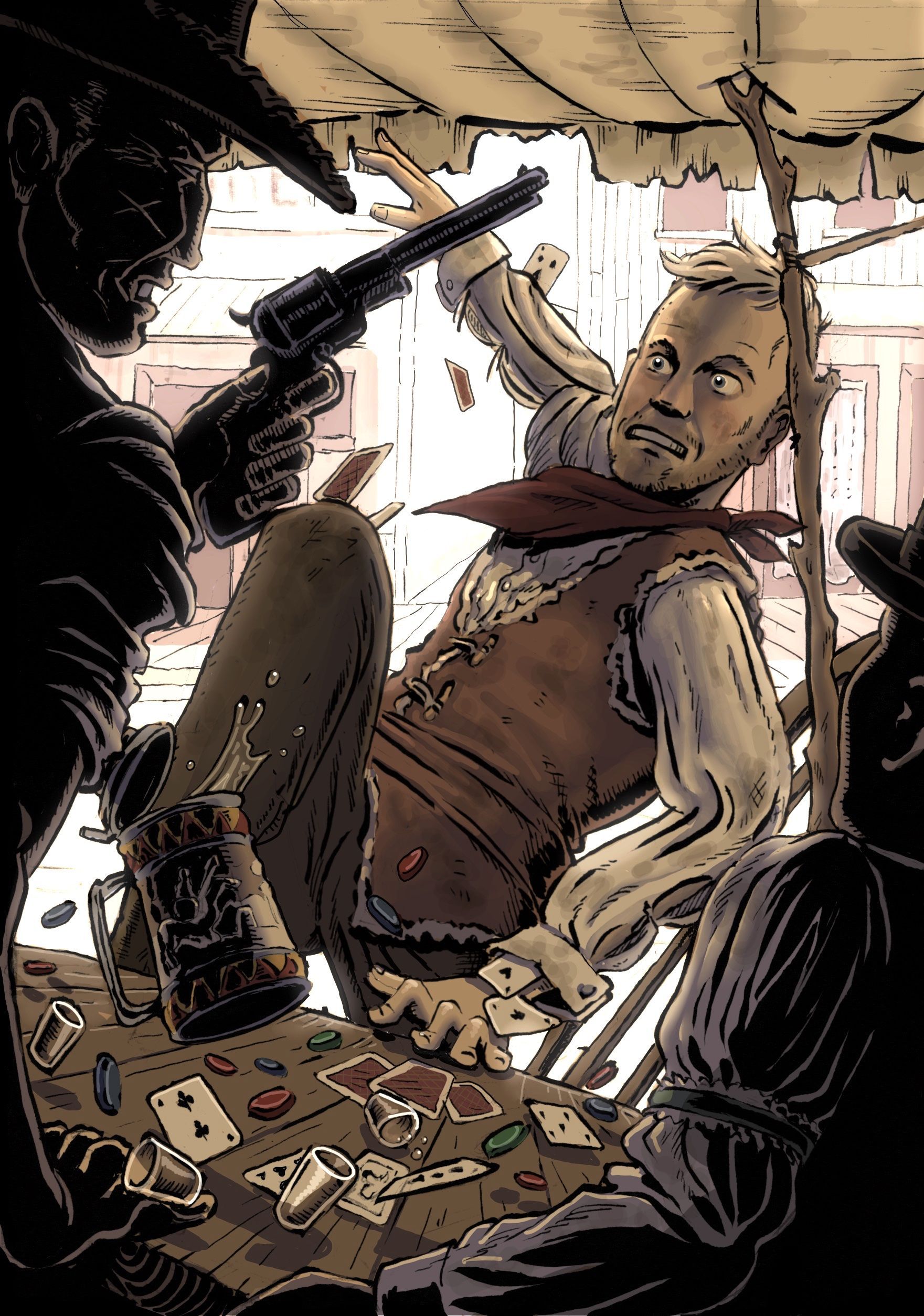
Artwork: (6/10)
The game’s cover art is great, and there some other pieces throughout the book that I also really enjoyed. Not all artwork in the book has the same style or quality, however.
For a kickstarted book, I was impressed at how much artwork is present. Finally, because of the Western-themed color choices and the great graphic design, I always felt like the aesthetic element only added to my experience of reading through the game’s rules.
Dead in the West RPG Ease of Purchase: (10/10)
Dead in the West is extremely easy to purchase. You can buy Dead in the West at its website, and find additional information on the game at its Kickstarter page.
Price & How Many Books Do You Need to Play: (10/10)
I’m always happy when I see that games are in the $15-20 range.
You can purchase a Dead in the West PDF copy for roughly $20, and a print/ PDF copy for about $50.
The Dead in the West rulebook comes with sections on character creation, lore, and a large section of the book on game master tools – basically everything you need to play in that one book. I do think Dead in the West could’ve used more information on enemy stats, but since there are sections for NPC character ideas and critters (that have stats included) any GM could make do only with what’s provided.
Ease of Starting a Group & Availability of Supplemental Material: (7/10)
People should play Dead in the West if they love the American West and the mythological stories it inspires.
Dead in the West RPG is not a famous game yet, but you can help make it so. My gaming group enjoyed playing, and we’re a pretty experienced group when it comes to different tabletop RPG system. So, I can confidently say that chances are good your players will have fun, as well. If any of your players love Dead in the West’s genre, then this game is a must-play.
At this time (so far as I can tell) there are no supplemental gaming materials available from Dead in the West.
Dead in the West is Produced By:
Will Donelson
Dice, Dungeons, Games & More - Eternity TTRPG
Share This Article

Author - Jacob Tegtman
Dear reader, I hope you enjoyed this article. Tabletop gaming has been a passion of mine since I was 6 years old. I've played just about every game from Dungeons and Dragons to video games like Final Fantasy. These games have inspired me, made me laugh, made me cry, and brought me endless hours of enjoyment.
I started Eternity TTRPG - and the indie tabletop game that goes along with it (Eternity Shop) - to share my love of gaming with others. I believe that in our technology-driven age, tabletop games help bring a sense of magic and community back into our world.
If you love the site, please share it with others! I have lots of gaming-related material for you to peruse and use in your own gaming sessions. If you have any questions about the site or want to contribute, just send me a message using the "Contact" page, which you can find in the site's footer.
